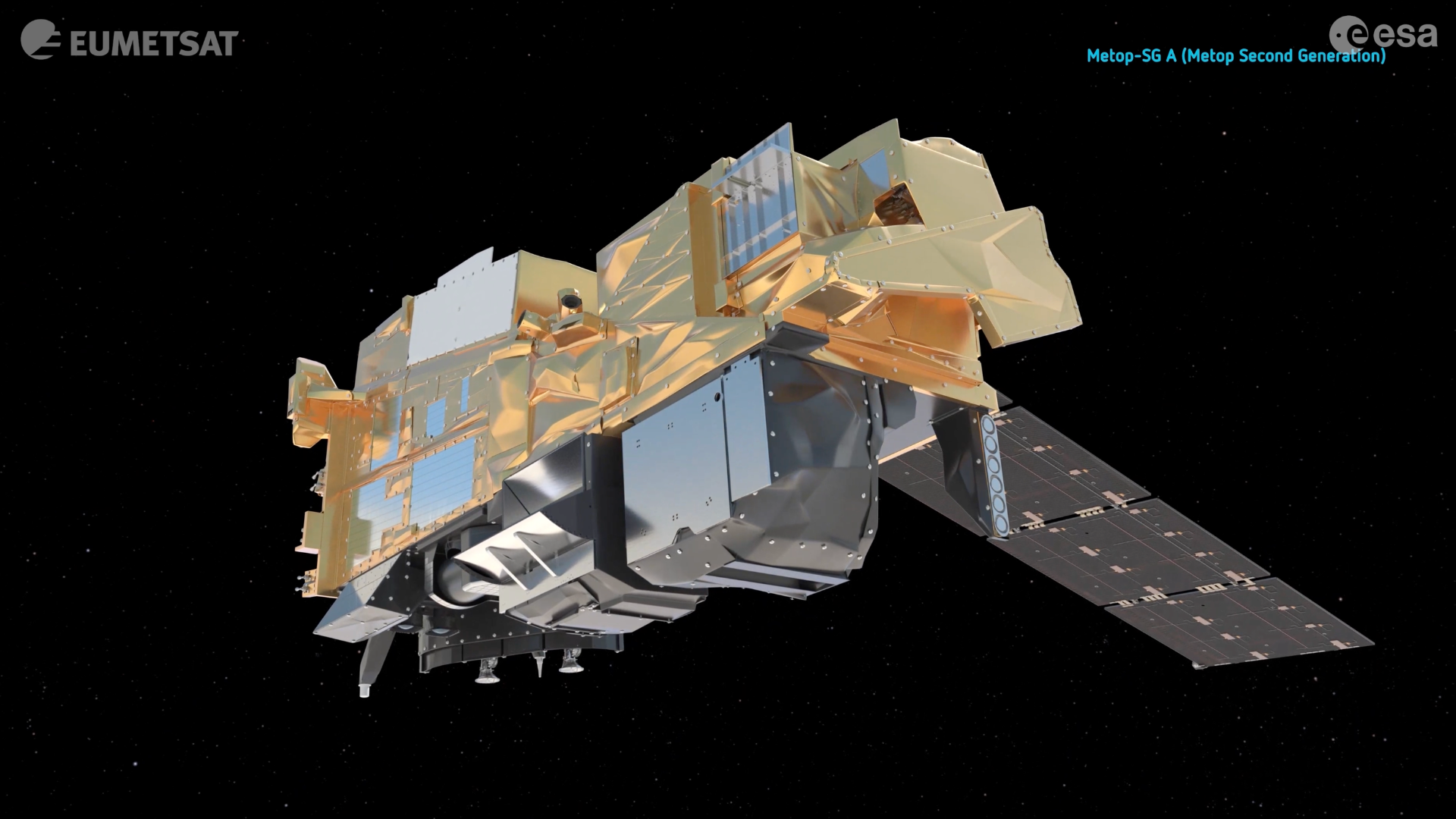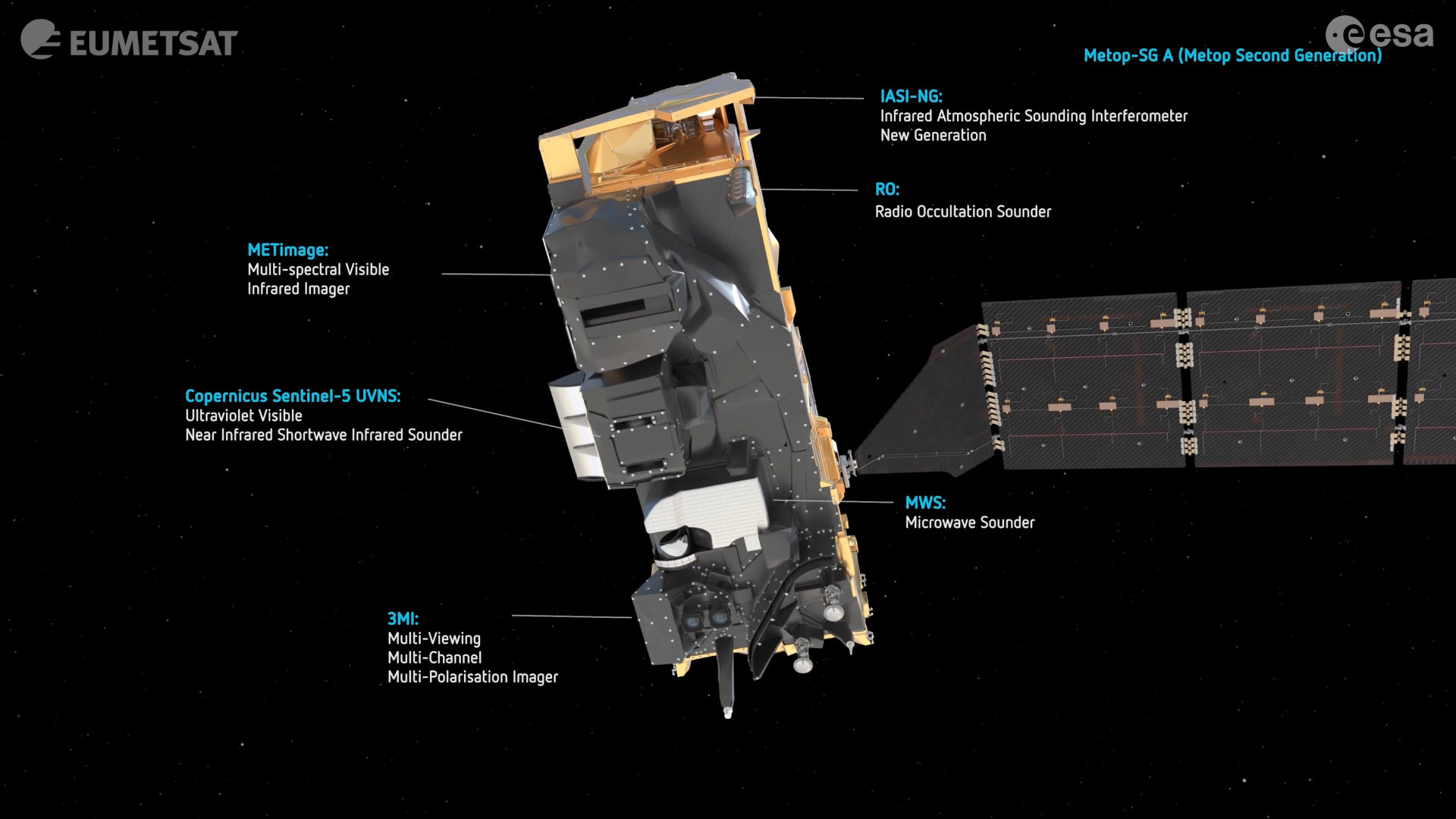New satellite will help ‘transform’ forecasting capability
Author: Press Office
10:14 (UTC+1) on Tue 12 Aug 2025
The first satellite in a series of six that will launch over the next fifteen years takes flight this week [13 August] as part of an international project to advance global observations to enhance weather forecast accuracy.
Metop-SG A1 is the first satellite as part of the Metop Second Generation series and is scheduled to launch from French Guiana in the early hours of 13 August, BST.
The launch, led by EUMETSAT and the European Space Agency, will send the satellite into a low-earth orbit and will start the long-term project of enhancing and replacing Metop First Generation, which is gradually coming offline over the next few years after around 15 years of service.
A polar orbiter, Metop-SG A1 will get into position around 800km above the Earth and will complete one full orbit every 100 minutes, passing close to the north and south poles. This will allow imaging of the entire globe over the course of the day for some instruments.
Once operational, new and more detailed data will be able to be assimilated into numerical weather prediction forecast models, further enhancing forecast accuracy at a global and national scale.
Met Office Managing Director of Products and Services Simon Brown is part of the team that represents UK and Met Office interests within EUMETSAT. Speaking ahead of the launch, he said: “Trusted weather and climate intelligence begins with having the most detailed and accurate observations you can, and that’s why the Metop Second Generation series is so important, not only to us at the Met Office, but also for global forecasting capability.
“This launch marks the start of a transformation for global weather monitoring, which will enhance the data we can ingest into our new supercomputing infrastructure in the coming years.”

UK Science Minister Lord Vallance said: "Our weather is becoming more extreme and more unpredictable. This launch is the latest result of the UK investing with European partners to bolster weather predictions so we can keep up with our changing climate.
“Harnessing the world-class insights from this satellite, will improve our ability to predict high impact weather events even earlier. This will protect our infrastructure, our economy, and save lives, keeping our Plan for Change on track."
Satellite data is the largest contributor of all types of observations to numerical weather prediction accuracy and more detailed observations from the satellite will enhance the complex calculations that can be made as part of weather forecasting, enhancing accuracy.
A 2024 study by London Economics concluded that Met Office returns £19 in value for every £1 invested, and the benefits from using Metop-SG data will form a large component of Met Office impact on society. In addition, a recent report on the UK Space Industry suggested that sectors that rely on satellite services represent 18% of total UK GDP.
Metop-SG A1 includes a variety of equipment relevant for data collection and weather monitoring, including imagers and sounders. The new infrared sounding interferometer collects data from around 18,000 spectral channels, which is a significant upgrade on the previous generations which had around 8000 channels.
The increased resolution of data is invaluable to weather forecasters, according to Met Office Head of Space Applications and Nowcasting R&D Simon Keogh. He said: “We know how important satellite data is for forecast accuracy, with around a quarter of existing accuracy coming from this source. The next generation of these satellites is important not only for maintaining existing accuracy as old systems go offline, but also for enhancing observations for the next generation of weather forecasts.
“This project is absolutely vital as we make sure we can continue to deliver more accurate forecasts for the next five days and beyond.”

EUMETSAT’s Director General Phil Evans said: “Extreme weather has cost Europe hundreds of billions of euros and tens of thousands of lives over the past 40 years—storms like Boris, Daniel and Hans, record heatwaves and fierce wildfires are just the latest reminders.
“The launch of Metop-SG A1 is a major step forward in giving national weather services in our member states sharper tools to save lives, protect property, and build resilience against the climate crisis. These positive impacts will be felt even beyond that and over the Atlantic, as Metop-SG A1 is Europe’s first contribution to the Joint Polar System with NOAA.
“This milestone reflects years of teamwork across EUMETSAT, ESA, the EU, CNES, DLR, Airbus, Thales Alenia Space, and many others. This is the beginning of an exciting new chapter as we work to ensure the satellite settles into orbit and starts delivering the vital data it was built to provide.”
It’ll take around a year before Metop-SG A1 completes its commissioning phase and starts providing operational data. Met Office will receive data both from EUMETSAT and also directly from the satellite as it passes overhead via a newly installed satellite tracking dish at Met Office headquarters in Exeter.
This mission will also include the Copernicus Sentinel 5 mission, which will primarily be used for monitoring air quality and long-term climate monitoring. The project will add to European environmental monitoring infrastructure, supporting policy, research and public health initiatives.
Metop-SG A1 and Sentinel-5 has had significant UK industry involvement providing the Microwave Sounder instrument, critical components, and calibration and test facilities.
Harshbir Sangha, Director of Missions and Capabilities at the UK Space Agency, said: “The UK space sector has played a pivotal role in advancing two crucial Earth observation missions - MetOp-SG and Sentinel-5. With key technology contributions from RAL Space in Harwell, Airbus Defence & Space in Portsmouth developed the sophisticated microwave sounder aboard MetOp-SG that provides essential temperature and humidity data for weather forecasting. RAL Space is also spearheading the calibration and validation work for both this instrument and the Sentinel-5 spectrometer, ensuring the scientific integrity and precision of the data that will benefit communities worldwide.”
“This collaboration showcases the breadth and depth of the UK's Earth Observation capabilities, from cutting-edge instrument manufacturing to world-class data validation, reinforcing our position as a global leader in satellite-based environmental monitoring.”
Dr Richard Siddans, Sentinel-5 Mission Advisory Group member at RAL Space and the National Centre for Earth Observation said: “My colleagues from RAL Space and NCEO have been involved with both hardware development and data processing for the MetOp-SG and Sentinel-5 missions, and after years of dedication, it's incredibly exciting to see these missions finally launch.
“Insights from the MetOp-SG series will benefit weather forecasting, environmental monitoring and policy-making for decades to come. It’s a significant leap forward in our ability to monitor atmospheric composition from space.”
The next launch in the Metop Second Generation series is currently scheduled for later in 2026, with the launch of Metop-SG B1 which focuses on microwave imaging and sounding.
This series of launches is complementary to the Meteosat Third Generation missions, which provides geostationary satellites focused on Europe, with the most recent launch last month.


